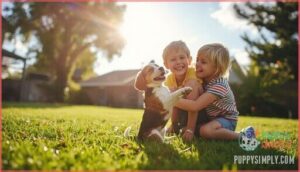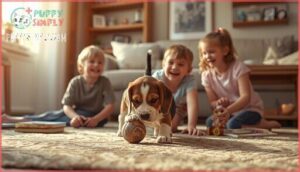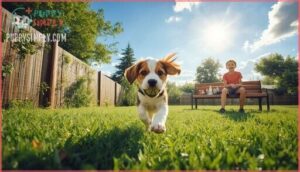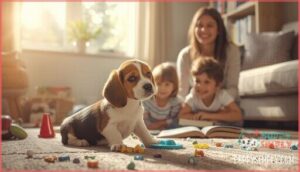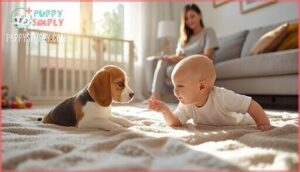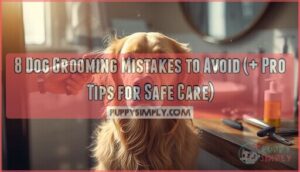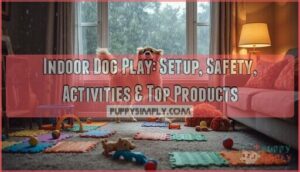This site is supported by our readers. We may earn a commission, at no cost to you, if you purchase through links.

Beagles consistently rank among family-friendly breeds, but the puppy phase brings unique challenges that can make or break the experience. With their gentle temperament and playful energy, beagle puppies often thrive with children—yet fewer than half of families understand the time investment and supervision required in those critical first months.
The decision hinges on understanding both the breed’s natural strengths and the real-world demands of raising a puppy alongside kids.
Table Of Contents
- Key Takeaways
- Beagle Temperament and Personality
- Beagles Are Good With Kids
- Challenges of Raising a Puppy and Kids
- Training a Beagle Puppy
- Beagle Puppy Exercise Needs
- Beagle Health Concerns for Kids
- Having an Infant and a Puppy
- Beagle Costs and Preparation
- Frequently Asked Questions (FAQs)
- Are Beagles kid friendly?
- Are Beagles good dogs?
- Should you teach your children to respect a beagle puppy?
- Is a Beagle suitable for a family?
- Is a Beagle a good companion for babies?
- Can a beagle play safely with an infant?
- How long can a beagle puppy be left alone?
- What size home or yard is recommended for a beagle puppy?
- How do I introduce a new beagle puppy to other pets?
- What basic commands should I teach a beagle puppy?
- Conclusion
Key Takeaways
- Beagles rank among the most family-friendly breeds due to their gentle temperament, naturally affectionate nature, and fewer than 10% showing higher-than-average aggression, making them reliable companions for children when properly socialized.
- Raising a beagle puppy with kids demands significant time investment—families report spending about 2 extra hours daily on supervision and cleanup, with first-year costs ranging from $1,400 to $2,300 and inconsistent handling potentially extending training by up to 50%.
- Children under 10 face elevated safety risks since most dog bites occur with familiar household pets, making constant parental supervision and teaching kids to respect puppy boundaries absolutely essential for preventing injuries during the critical first months.
- Successful beagle-child relationships require consistent positive reinforcement training (which reduces problem behaviors by half within six months), daily exercise of 5 minutes per month of age for puppies under 18 months, and regular veterinary care to manage health concerns like zoonotic diseases and genetic disorders.
Beagle Temperament and Personality
Beagles bring what many families dream of—a dog that’s both playful and patient. Their social temperament shines in family settings, where they form strong bonds with both adults and children. With an affectionate nature that’s backed by behavioral data showing fewer than 10% display higher-than-average aggression, these dogs naturally fit into homes with kids.
You’ll notice their tracking instincts at work during backyard adventures, as those 220 million scent receptors keep them curious and engaged. While trainability requires patience—they rank 72nd in obedience intelligence due to their independent streak—positive reinforcement works wonders. Their gentle nature makes them excellent companions, though their vocalization habits mean you’ll hear plenty of barking, baying, and howling.
That loving temperament and beagle temperament with children create a foundation for lasting friendships. Beagles also require weekly brushing due to shedding. Their compatibility with kids stems from being naturally affectionate rather than aggressive, making them reliable family members when properly socialized.
Beagles Are Good With Kids
Beagles have earned their reputation as wonderful companions for children, and there’s good reason for that. Their naturally friendly disposition and boundless energy make them well-suited to family life.
Let’s look at what makes these pups such great matches for kids.
Energetic Playmates
Regarding playtime, you’ll quickly discover your beagle puppy has energy levels that rival your child’s excitement on a Saturday morning. These pups need at least 60 minutes of exercise daily, and interactive play sessions give kids and puppies a chance to burn off steam together.
Interactive games like fetch, hide-and-seek, and simple agility exercises create wonderful bonding moments while addressing childhood obesity concerns through active outdoor time. Your beagle’s playful demeanor naturally draws children into movement-based activities, turning exercise requirements into fun adventures rather than chores. This shared puppy energy builds routines where both your child and your pup develop healthy habits that stick.
Beagles are known for their highly developed sense of smell, which can be incorporated into scent-based games.
Friendly and Loving
Beyond the energy, you’ll also notice your beagle’s affectionate nature shines through in everyday moments. Beagles rank among the top five friendliest breeds, and over 80% of families report positive experiences with these gentle, loving personalities around young children.
Their pack-dog heritage creates natural social harmony, helping them form strong family bonds quickly. This loyalty translates into patient, gentle interactions—your beagle will treat your kids as cherished members of the pack, making them remarkable family pets who thrive on togetherness.
Challenges of Raising a Puppy and Kids
While beagles make terrific family dogs, bringing home a puppy when you’ve got young children isn’t a walk in the park. American families juggling both report spending about 2 extra hours daily on supervision and cleanup—that’s real time management pressure. You’ll also see behavioral conflicts emerge; inconsistent handling by kids can extend training by up to 50%, and puppies may show more stress-related mouthing or growling.
Safety risks matter too. Most dog bites happen with familiar household dogs, and children under 10 are especially vulnerable. Parental supervision becomes non-negotiable for child safety with dogs. Emotionally, you might feel the strain—parents commonly report a 28% rise in fatigue during those early months.
Most dog bites occur with familiar household dogs, and children under 10 face heightened risk without constant parental supervision
Add in financial strain—first-year puppy costs average $1,400 to $2,300—and you’re looking at a significant commitment. With patience and structure, though, your family can navigate these challenges successfully.
Training a Beagle Puppy
Training a Beagle puppy takes patience, but it’s worth the effort when you have kids in the home. These smart dogs respond well to consistent training methods, though their independent streak can test your resolve.
Let’s look at three key areas you’ll need to focus on to raise a well-behaved Beagle that’s safe and reliable around your children.
Housetraining
Most puppies aren’t born knowing house rules—you’ll need to teach them. Housetraining your beagle puppy generally takes 4 to 6 months with schedule consistency and positive reinforcement methods. Crate training works well since puppies avoid soiling their sleeping space.
Take your pup out every 2 hours at 2 months old, extending gradually as bladder control improves:
- First thing each morning and right before bed
- Immediately after meals, naps, and play sessions with children
- To the same outdoor spot, rewarding success with treats and praise
Clean accident setbacks thoroughly with enzymatic cleaner to prevent repeat marking. Age considerations matter—puppies under 12 weeks need more frequent breaks and patience during dog training.
Recall Skills
Since beagles have powerful noses and strong scent drives, teaching recall commands becomes one of your most important dog training priorities. Start early—puppies trained before 12 weeks show 36% better engagement than those starting later.
Practice recall in low-distraction settings first, where success rates can reach 80% after consistent daily training. Use high-value treats to boost response rates by up to 40%.
Gradually introduce distractions as your pup matures, knowing outdoor reliability often drops to 30–50% initially. Make recall training fun with games like "Catch Me"—these methods improve response by 28% within four weeks.
Positive Reinforcement
When you work with positive reinforcement training, you’re tapping into what science shows works best for beagles and children alike. Reward good behavior immediately with treats or praise—dogs trained this way show 30–40% lower stress levels and maintain skills longer.
Training consistency builds trust and reduces problem behaviors by half within six months. This approach strengthens positive relationships between your beagle and kids, teaching both patience and respect.
Never punish accidents; instead, redirect and reward desired actions to create lasting behavior modification that benefits everyone.
Beagle Puppy Exercise Needs
Your growing Beagle puppy needs the right amount of exercise to stay healthy without overdoing it. Puppies under 18 months require about 5 minutes of structured activity per month of age—so a 6-month-old needs roughly 30 minutes daily, while a 10-month-old benefits from 50 minutes. Break these sessions into shorter bursts to prevent fatigue and protect developing joints.
Mix moderate walks with cardio games like fetch or tug-of-war, and let your puppy explore scent trails during outdoor time for mental stimulation. This mental engagement is just as important as physical playtime, helping prevent boredom-related behaviors like chewing or digging.
Once your Beagle reaches adulthood, they’ll need 60 to 90 minutes of exercise regularly to maintain muscle tone and prevent obesity. Consistent activity keeps energy levels manageable around kids while supporting long-term metabolic health benefits.
Beagle Health Concerns for Kids
Regarding dog health and child safety, a few preventative care steps go a long way. Beagles can carry zoonotic diseases like ringworm or intestinal parasites that spread through direct contact, so hygiene practices matter. Teach your kids to wash their hands after playing with the puppy—this simple habit reduces transmission risk by 35 to 60 percent. Regular vet visits catch genetic disorders early, including hip dysplasia and epilepsy, which affect up to 6 percent of Beagles.
Watch for these health concerns that impact kids:
- Allergic sensitivities: About 15 percent of Beagles develop skin allergies, and dander exposure can worsen asthma symptoms in sensitive children
- Ear infections: Those adorable floppy ears trap moisture, leading to infections that need prompt treatment
- Food sensitivities: Roughly 5 to 8 percent react to common proteins, requiring dietary adjustments
Supervise interactions closely, schedule monthly parasite checks, and groom weekly to manage shedding and pet health.
Having an Infant and a Puppy
Adding a Beagle puppy to your home when you have an infant requires careful planning and realistic expectations. Children under five account for 26% of all dog bites in the U.S., with infants facing the highest risk for facial injuries. That’s why supervision isn’t optional—77% of bites happen with familiar pets in family settings.
Before bringing your puppy home, introduce baby-related sounds and smells to help your Beagle adjust. Hygiene protocols matter too: wash your hands after handling your puppy, especially before preparing bottles or touching pacifiers.
Here’s what makes this work:
- Create physical boundaries using baby gates or crates to prevent unsupervised interactions, which reduces accident risk by 63% while establishing safe introductions between infant and puppy.
The emotional benefits are real—infants raised with dogs show 27% fewer allergies and improved social development. With parental supervision, gentle introductions, and a safe environment, your infant and puppy can grow up as companions.
Beagle Costs and Preparation
Beyond the joys of raising a puppy alongside your infant, you’ll need to prepare financially and practically before your Beagle arrives. The adoption vs. purchase decision matters—adoption costs $100 to $400 and includes vaccinations and spaying, while purchasing from a breeder runs $400 to $1,200, sometimes reaching $2,000 for champion bloodlines.
Your initial supply list should include a crate ($100–$280), bowls ($10–$80), leash, collar, bed, and toys, totaling $200–$500.
Long-term expenses add up: expect $1,716–$3,900 annually for food, vet visits, grooming, and preventive care.
| Cost Category | Annual Range |
|---|---|
| Food & Treats | $240–$720 |
| Vet Care & Meds | $396–$780 |
| Grooming | $300–$600 |
Insurance options ($25–$75 monthly) can cushion emergency expenses. Budgeting tips for families with kids: set aside funds for training classes early—behavior issues prevented now save thousands later, making Beagles safer family pets.
Frequently Asked Questions (FAQs)
Are Beagles kid friendly?
Yes, Beagles are generally kid friendly. Their even-tempered, gentle nature makes them excellent family pets. With proper socialization from a young age, they’re tolerant and accepting of children, though supervision needs remain important for safety.
Are Beagles good dogs?
Beagles make wonderful family pets when you understand their needs and quirks. Their friendly temperament and gentle nature shine brightest when paired with consistent training, daily exercise, and regular veterinary care, creating loyal companions for years to come.
Should you teach your children to respect a beagle puppy?
Teaching your children to respect a beagle puppy is absolutely essential for safe playtime between Beagles and children.
Kids should learn gentle handling, boundary setting, and how to read body language, which prevents bites and builds mutual respect.
Is a Beagle suitable for a family?
With their gentle temperament and playful energy, Beagles are well-suited as family pets when properly trained and supervised.
Their compatibility with kids depends on consistent training needs, early socialization, and understanding their behavior with children, ensuring safe family lifestyle integration.
Is a Beagle a good companion for babies?
With proper introduction and supervision, Beagles can be wonderful companions for babies. Their tolerant, affectionate nature makes them suitable for infant households when adequately exercised and socialized early.
However, Baby-Safe Beagles require careful Infant Interaction Training and constant Beagle Supervision Needs to guarantee positive Child-Dog Bonding during the Beagle Puppy Introduction phase.
Can a beagle play safely with an infant?
Like introducing two toddlers at a playground, supervised interactions between Beagles and infants require constant adult oversight to guarantee safe play.
Beagles generally show friendly temperament around kids, but bite prevention depends on proper supervision, gradual introductions, and respecting the puppy’s limits during infant interactions.
How long can a beagle puppy be left alone?
You shouldn’t leave a beagle puppy alone for more than one to two hours if they’re under six months old.
Their age determines duration—younger puppies need more frequent bathroom breaks and companionship.
Start with short separations, gradually building tolerance through crate training and positive reinforcement to prevent separation anxiety and destructive behavior.
What size home or yard is recommended for a beagle puppy?
You don’t need acres of space or a sprawling backyard. A beagle puppy thrives in apartments or smaller homes if you exercise regularly and provide playtime.
Aim for 40 to 60 minutes of daily activity through walks, indoor enrichment, and secure yard access when possible, adapting to their energy levels and your home environment.
How do I introduce a new beagle puppy to other pets?
Start by separating your beagle puppy from other pets for at least two weeks, swapping bedding to enable scent familiarization.
Use supervised introductions with barriers, reward calm behavior, and manage resources like food bowls separately to prevent stress signals and promote positive socialization.
What basic commands should I teach a beagle puppy?
Teach your beagle puppy five essential commands: Sit, Stay, Come, Leave it, and Heel. These form the foundation of obedience and safety, especially around kids.
Positive reinforcement with treats works best for beagles, and short training sessions keep them engaged.
Conclusion
Raising a beagle puppy alongside children is like planting a garden—it requires patience, consistent care, and realistic expectations about the growing season ahead. Are beagle puppies good with kids? Yes, when you commit to supervision, training, and meeting their exercise needs.
The bond they form can become one of your family’s most cherished relationships, but only if you’re prepared for the work those first months demand. Skip the shortcuts, invest the time, and you’ll raise a companion your kids will remember forever.


